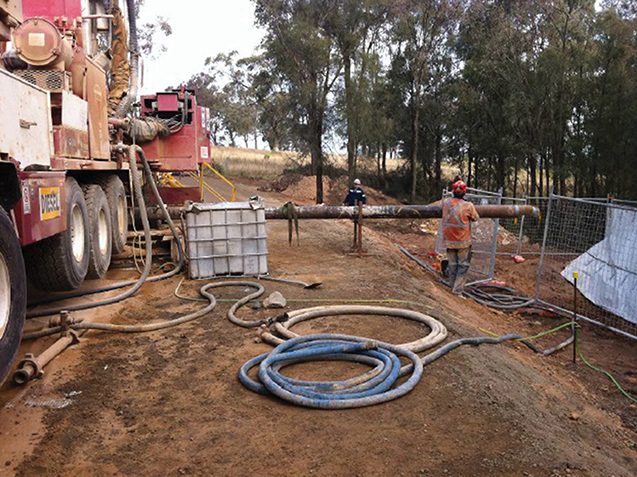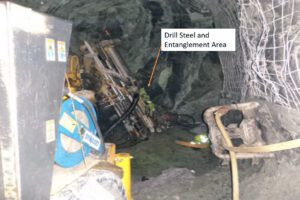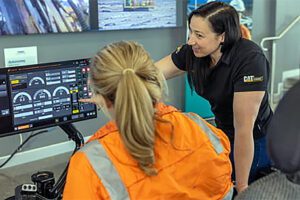The following case study is an extract of an investigation report prepared by the NSW Mine Safety Investigation Unit: “Investigation into a serious drill rig accident at Ashton Coal Mine on 12 August 2012”. This extract has been published in Australian Mine Safety Journal with kind permission of NSW Mine Safety and NSW Trade and Investment.
For the full report visit: www.resourcesandenergy.nsw.gov.au/safety
CASE STUDY
About 2.00 pm on 12 August 2012, a 26-year-old drill rig operator was seriously injured at the Ashton coal mine in the NSW Hunter Valley.
Silver City Drilling (NSW) Pty Ltd employed the driller. The incident occurred within the surface boundary of Mining Lease 1533.
Silver City Drilling was conducting a drilling operation under contract from Ashton Coal Operations Pty Ltd for the purpose of installing a dewatering pump to dewater the underground longwall operation. The incident site was known as dewatering Borehole 4.
The drilling technique used at the time was air rotary hammer. Air rotary hammer drilling is primarily used in hard formations where penetration rates are superior to other rotary techniques such as rotary mud. The air rotary hammer technique uses a down hole hammer incorporated into the bottom hole assembly that achieves penetration through a rapid succession of impacts causing the rock formation to break. Compressed air and water mist, or compressed air and foam removes the rock chips (cuttings). This is commonly known as a drill fluid. This air was used to expel drill cuttings from the hole to a purpose-built sump via an air discharge line known as a “blooie line”.
The air discharge line was a 220 mm diameter steel pipe that was about five metres long with a 90 degree elbow attached. The air discharge line traversed below the driller’s platform and was secured to the ground with two star pickets and wire.
The drilling operation was delayed on the day of the incident because there was significant water flowing into the borehole from an alluvial aquifer. This water was filling the sump at an elevated rate, which led to down time as the sump had to be pumped out using two water cartage trucks contracted for the task.
During the day, discussions took place about the excessive water in the borehole and changing the drilling technique to rotary mud. Rotary mud drilling uses a rotating grinding tool instead of a hammer bit. The drill fluid used to remove the cuttings from the hole is usually a weighted bentonite (water-based) mud as opposed to compressed air. Nevertheless, the air rotary hammer method was continued.
At the time of the incident, the driller was in the process of lowering the drill rods to the bottom of the hole when a large pressure event occurred. The surface casing was pushed out of the ground and made contact with the bottom of the drill rig. The air discharge line broke free of its securing system and travelled in an upwards arc and hit the hinged driller’s platform where the driller was working. The force of the impact lifted the hinged platform upward and the driller was forced up against the control panel until the air discharge line travelled past the drilling platform. The driller and the platform fell with the driller coming to rest with his neck across the driller’s platform guard rail. The air discharge line then fell down striking the driller on the back of the neck.
The driller sustained multiple injuries including complete disruption of the spinal column at C4-C6 vertebra, a severed carotid artery and a severe laceration to the back of his head. He was flown to Royal North Shore Hospital where he underwent emergency surgery. The driller sustained permanent incapacitating injuries.
Contributing factors
The Mine Safety Investigation Unit conducted an investigation into the cause and circumstances of this incident. The following factors contributed to the incident:
- The conductor casing was not installed to a sufficient depth to isolate the Bowman Creek/Hunter River alluvials.
- Excessive water entered the borehole and created hazardous drilling conditions.
- The design and modification of the air discharge line to include a 90 degree elbow created additional risk to the system of work.
- The design of the air discharge line anchoring system was ineffective.
- The design of the drill pad and orientation of the drill rig required the air discharge line to travel under the drilling platform.
- An alternative method of drilling (i.e. mud drilling) was available and was more suitable for the drilling conditions at Borehole 4, but was not used.
- Risk management processes were not undertaken in relation to site specific conditions, specific drilling techniques and the prescribed system of work.
- Identification and management of the risks associated with the change in the system of work did not comply with the documented change management procedure.
- Supervisors did not ensure that workers conformed to the agreed system of work stipulated by the Ashton Coal Operations contract proforma.
The equipment
Silver City Drilling used a Schramm T130XD drill rig for drilling operations at the Ashton Coal Operations. The specifications of the rig are as follows:
- 130,000 pounds pull back pressure
- Capable of 22” hammer hole to 500 metres
- Capable of 8” hammer hole to 1000+ metres
- Head travel 15 metres.
An assessment and functional test was carried out on the rig post incident. There were no adverse findings related to the function of the rig.
Drilling with the air rotary hammer technique requires air pressure. Air pressure was supplied to the drill rig with three Sullair 900XHH/1150XH air compressors.
These compressors can run in two modes, high and low pressure. The parallel configuration of the three compressors at Borehole 4 meant that the pressure and volume obtained would have been about 2400kPa and 1628l/s when on low setting and 3100kPa and 1274l/s when on high setting.
The original equipment manufacturer (OEM) reported that there were no functional issues with the compressors when they were tested after the incident.
Development of drilling pads for Boreholes 3 and 4
The drill rig and load safe rod handler required a drilling pad to be constructed before the rig and ancillary equipment could be set up. Consultation between the contract holder and the Silver City Drilling operations manager was undertaken at both borehole locations before work began.
Ashton Coal Operations were unsure of the area the Silver City Drilling rig would require. The Silver City Drilling operations manager informed Ashton Coal Operations about the size and nature of the drill pad design for both borehole locations.
Drilling accident investigation – Drilling at Borehole 3
Silver City Drilling representatives were first contacted by Ashton Coal Operations in June 2012. The nature of the work described to the company was to drill a dewatering borehole at the Borehole 3 location. This hole was to be a blind borehole, targeting the Upper Liddell seam approximately 180 metres below the ground, which underground mining operations would intersect at a later date.
The planning phase for Borehole 3 began before Silver City Drilling was contracted to undertake drilling the borehole. Initially, Ashton Coal Operations approached a local drilling company to undertake the drilling operation however, they were not confident that their equipment was powerful enough to undertake such a large diameter blind borehole to the depths required.
At that time, a formal risk assessment involving contract geologists, the local drilling company staff, and Ashton Coal Operations employees had been undertaken. This risk assessment did not take into account the actual drilling operations. Instead it focused on the ancillary tasks that would be performed on the site, such as mobilisation, running casing and vehicle interactions.
After Silver City Drilling was awarded the contract to undertake the drilling operations at Borehole 3 the contractor proforma review was undertaken. Part of the early interactions between Silver City Drilling and Ashton Coal Operations involved the review of the local drilling company’s risk assessment. There is no evidence that Silver City Drilling communicated the contents of the risk assessment to the Silver City Drilling employees that were to undertake the work.
Borehole 3 was located on the side of a ridge that runs across the south eastern quadrant of ML1533. Ashton Coal Operations designated this to be an area of voluntary conservation.
Due to the voluntary conservation constraints placed on the operation, the drill pad design was critical. Silver City Drilling specified the drill pad requirements to the contract holder. The drill pad was a terraced design, whereby the drill rig sat on an upper level of the terrace, and the sump sat on a lower terrace approximately two metres below.
Drilling at Borehole 3 required the installation of conductor casing into bedrock. This is standard procedure for this type of drilling.
Drilling began on 27 June 2012, about 4.30pm. The conductor casing was set to a depth of five metres as this was as far as the drill rig could penetrate with the large diameter spade bit required for opening the hole to the required diameter. A bore log of a borehole near to Borehole 3 suggests that bedrock (consolidated ground) started at a depth greater than 7.5m.
The lack of capability of the spade bit to penetrate to a greater depth appears to have been associated with the condition of the spade bit. It was reported that the spade bit was well worn with many of the tungsten carbide cutting edges worn out.
On 4 July 2012, an environmental incident was reported to the contract holder involving drill fluid and cuttings being ejected over the sump wall.
Following the environmental incident, drilling operations continued until Silver City Drilling broke a 22 inch reaming head in the process of opening up the pilot hole at a depth of 48 metres. Efforts to retrieve the tool bit were unsuccessful and a decision to abandon the hole was taken by Silver City Drilling and Ashton Coal Operations.
Silver City Drilling and Ashton Coal Operations proposed that the rig be moved five metres to the west (still on the same drill pad), where drilling operations restarted. Silver City Drilling experienced the same issues with the conductor casing installation and again installed the conductor to a depth of five metres.
Drilling operations at the new Borehole 3 site proceeded, with only a few minor issues, until, a second environmental incident was reported to the contract holder, who directed Silver City Drilling to ensure that drill cuttings from the air discharge line be diverted to the sump, and not the surrounding environment.
Following these incidents, Silver City Drilling added a 90 degree elbow to the end of the air discharge line.
The change in air discharge line design at Borehole 3 to incorporate a 90 degree elbow represented a significant change to the design of the rotary air hammer drilling system, which meant a significant change in the directional forces created by the air discharge line. This change led to jet forces from the air/water discharge shifting from horizontal to vertical. There was no documented risk assessment process undertaken by Silver City Drilling in relation to the change to the air discharge line to incorporate a 90 degree elbow.
Drilling accident investigation – Drilling at Borehole 4
Drilling at Borehole 3 was completed on 7 August 2012 at which time Silver City Drilling moved the drill rig to the Borehole 4 location. As with the earlier drill pad, this drill pad was constructed by Ashton Coal Operations in consultation with Silver City Drilling.
As part of the risk management consultation between Silver City Drilling and Ashton Coal Operations a documented risk assessment process was undertaken for the Borehole 4 site. This risk assessment process was similar to the one completed between the local drilling company and Ashton Coal Operations on Borehole 3 and did not cover site-specific drilling operations.
The location of the Borehole 4 site was somewhat different to the Borehole 3 site. Instead of being on a ridge, the site was in the south west corner of ML1533 in an area colloquially known as the Bowmans Creek/Hunter River alluvial plains.
The intended procedure for this borehole was to intersect mining operations in the Pikes Gully Seam (193 metres deep) for the purpose of dewatering the longwall operation.
Information provided to Silver City Drilling by Ashton Coal Operations suggested that the alluvial layer (unconsolidated layer) at the Borehole 4 site was approximately 20 metres deep. As a result of this, two 12 metre lengths (total 24 metres) of conductor casing were ordered by Ashton Coal Operations for the drilling operations at Borehole 4. It was intended that the alluvial section would be cased off to this depth.
Drilling started on Borehole 4 on 9 August 2012. Difficulties were experienced by another Silver City Drilling driller who, while drilling the pilot hole for the conductor casing, reported that the hole was ‘collaring badly’ and the top 20 metres consisted of gravel.
The work roster for Silver City Drilling typically involved two drilling crews working alternate fortnights.
On 10 August 2012 the drilling supervisor and the driller involved in the incident replaced the back shift crew. The driller did not review the previous crew’s drilling activities log sheet at the start of his first shift.
The driller started reaming out the pilot hole with the large diameter spade bit used on Borehole 3. At about 12 metres he reported that he was unable to achieve further penetration and a drilling supervisor decided to stop drilling and run casing to this depth.
The investigation confirmed that the exact depth of conductor casing was 11.4 metres, while the unconsolidated layer was between 20 and 30 metres. It is important to note that while the alluvial layer was approximately 12-14 metres deep the weathered unconsolidated layer went far deeper.
After the installation of the casing and grouting had been completed the drilling of the pilot hole began on 11 August 2012.
As this site was considered an archaeologically significant site by Ashton Coal Operations, Silver City Drilling was told that there could be no environmental incidents. As a result, Silver City Drilling chose to leave the 90 degree elbow on the end of the air discharge line.
Drilling proceeded on 12 August 2012 until the pilot hole reached approximately 85 metres. At this stage, water production was becoming a significant issue for the drilling operations. Water production became so significant that the hole was producing approximately 15,000 to 20,000 litres of water every hour.
This water production resulted in elevated sump levels. Penetration had significantly slowed as the drill rig had to wait for the sump to be pumped out regularly.
On the same day, the driller discussed the site conditions and excessive water with the drilling supervisor and suggested that the conditions required a change in drilling technique from air rotary hammer to rotary mud drilling. The driller reported that at one stage he turned the drill rig off and proceeded to have a 45-minute discussion with his supervisor about the merits of continuing with the existing air drilling technique.
The driller reported that he shut the rig down because he had never seen so much water in a hole before and was concerned about the drill becoming stuck. He considered the water make was unusual, and that it was something he had never seen before. Nevertheless, the air rotary hammer drilling technique was continued. A review of the technique was planned to be undertaken that evening by Silver City Drilling.
The incident on 12 August 2012
About 2.00 pm that day, the Silver City Drilling supervisor and driller prepared to recommence air rotary hammer drilling at Borehole 4. While refuelling an air compressor, the supervisor confirmed the compressors and the drill rig were running. The driller was positioned on the drilling platform to operate the drill rig from its control panel. The supervisor confirmed that the driller had rotation on the drill string via a hand signal and the driller activated the air to the drill string and lowered the drill string to the bottom of the hole.
At that time, the supervisor reported that he heard an explosion and he saw the well unload. He saw the air discharge line shoot up in the air and hit the hinged drilling platform that the driller was standing on. The force of the impact lifted the hinged platform in an upward direction and the driller was forced upwards against the control panel until the air discharge line travelled past the driller’s platform. The driller and the platform fell back down with the driller coming to rest with his neck across the drilling platform hand rail. The air discharge line then fell, striking him on the back of the neck.
The supervisor ran to the drill rig control panel and turned the rig off. He then attended to the injured driller, contacted Silver City Drilling and requested emergency services. Silver City Drilling personnel contacted Ashton Coal Operations which initiated the mine’s emergency response procedures.
Emergency response personnel attended the scene. Due to the driller’s injuries and the equipment that he was trapped under, NSW Ambulance rescue had to cut him free from the equipment using the Jaws of Life. The time from when the incident occurred until the time the driller was airlifted from the scene was about two hours.
The driller sustained multiple injuries including complete disruption of the spinal column at C4-C6 vertebra, a severed carotid artery and a severe laceration to the back of the head. He was flown to Royal North Shore Hospital where he underwent emergency surgery. The driller sustained permanent incapacitating injuries.
Remedial safety measures
Following the incident Ashton Coal Operations undertook a number of reviews, and introduced system changes for drilling, contract management, emergency response, and safety management.
Various controls were put in place at Ashton Coal Operations drill sites as a result of the incident and drilling procedure review. For example, the driller must consider the following in their risk assessment: location of sump / air discharge line & anchoring; set up of drill pad; design of air discharge line (straight); restraining system against air discharge line movement; barricaded access for personnel to the air discharge line; position of operators; assessment of potential stored pressures in the drill hole including if the hole becomes blocked; engineering design of casing system in ground and above ground; verification process to confirm integrity of casing grouting (pull tests); and development of trouble-shooting Trigger Action Response Plans (TARP).
Drilling accident investigation – Recommended practice for industry
This drilling accident highlights the importance of an effective risk management program in relation to drilling operations. The following are recommended practices to industry to improve industry safety and reduce the likelihood of similar incidents reoccurring.
- Unconsolidated ground should be identified and effectively controlled via the use of adequate casing installed to the required depth.
- Site-specific drilling risks must be identified and controlled using the hierarchy of controls.
- The design and modification of drilling equipment should be risk assessed.
- Changes to drilling systems of work should be identified and adequately risk assessed.
- Air discharge lines must be secured and anchored effectively.
- Drill pad design should minimise the potential for hazards and take into account the location of sumps, location of operators and location of discharge lines
- The appropriate method of drilling should be identified and be suitable for site-specific conditions.
- Clear reporting lines and supervisory arrangements should be in place that clearly defines roles and responsibilities for drilling operations.
Read more Mining Safety News
















Add Comment